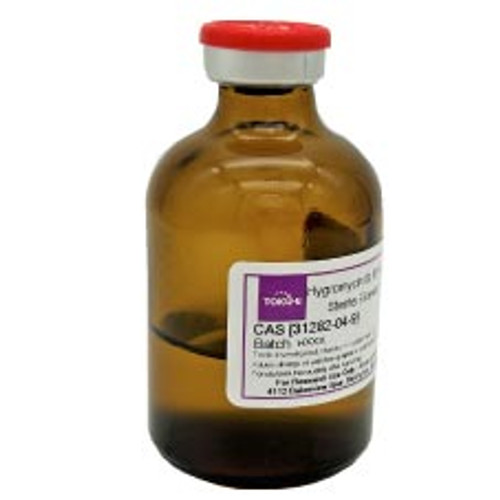Gentamicin ReadyMadeTM Solution is provided as a sterile-filtered solution of Gentamicin Sulfate formulated in water at a concentration of 50 mg/ml. It has been filter-sterilized using a 0.22 μm filter. Gentamicin Sulfate is routinely added to viral transport medium (VTM).
Gentamicin is an aminoglycoside antibiotic complex discovered in 1963 and is derived from fermentation of Micromonospora purpurea or M. echinospora composed of different components including the Gentamicin C complex (gentamicin C1, gentamicin C1a, and gentamicin C2) which makes up 80% of the compound and has the highest antibacterial activity. Gentamicin A, B, X, and a few others make up the remaining 20% of the compound and have lower antibiotic activity.
We also offer:
- Gentamicin Sulfate, USP (G006)
- Gentamicin Sulfate EP (G007)
- Gentamicin A Sulfate, EvoPure® (G035)
- Gentamicin C1 Sulfate, EvoPure® (G031)
- Gentamicin C1a Sulfate, EvoPure® (G032)
- Gentamicin C2 Sulfate, EvoPure® (G033)
- Gentamicin C2a Sulfate, EvoPure® (G034)
- Gentamicin C2b Sulfate, EvoPure® (G062)
- Gentamicin X2 Sulfate, EvoPure® (G036)
| Mechanism of Action | Aminoglycosides target the 30S ribosomal subunit, blocking the translocation of peptidyl-tRNA from acceptor to donor. This results in an inability to read mRNA ultimately producing a faulty or nonexistent protein. |
| Spectrum | Gentamicin Sulfate is broad-spectrum antibiotic targeting Gram-positive and Gram-negative bacteria. It is effective against several strains of Mycoplasma. It also combats certain β-lactam sensitive VRE or vancomycin resistant Enterococcus; a "superbug." |
| Microbiology Applications |
Gentamicin Sulfate is commonly used as a selective agent to select for cells containing the Gentamicin resistance gene, aacj-AaphD or aacC1. Gentamicin Sulfate is generally used at a concentration of 10 - 50 µg/mL for eukaryotic cells and 15 µg/ml for prokaryotic cells. Media Supplements Columbia Blood Agar - Gardnerella vaginalis Selective Supplement According to the CDC SOP (DSR-052-04) for Viral Transport Medium (VTM), Gentamicin Sulfate is used at a final concentration of 100 µg/ml. Our Gentamicin ReadyMadeTM solution can be added aseptically for streamlined workflows. |
| Plant Biology Applications | Gentamicin Sulfate inhibited differentiation of tracheary elements in pith parenchyma cells in cultures of romaine lettuce (Lactuca sativa L. var. romana) at concentrations of 50-100 µg/ml. Similar results were obtained with cultured explants of Jerusalem artichoke tuber (Helianthus tuberosus L.). Callus formation was suppressed with increasing levels of Gentamicin Sulfate in both tissue systems. When studying cell division or xylem differentiation in culture, recommended concentration is 10 µg/ml according to published sources. |
| Eukaryotic Cell Culture Applications | Gentamicin was found to inhibit Glucose-6-phosphate dehydrogenase (G6PD) enzyme activity in rat erythrocytes (Temel et al, 2018). A bovine macrophage (Bomac) cell line was used but proved to be contaminated with BVDV (bovine viral diarrhea virus). Both infected and cured cells were tested for uptake of Mycoplasma bovis in an in vitro model to dissect the molecular and cellular details of bovine mycoplasmosis using Gentamicin (TOKU-E) in a Gentamicin protection assay (Burgi et al, 2018). Gentamicin is an effective in vitro bacterial inhibitor that is nontoxic in tissue culture applications. It was non-toxic to RMK (Rhesus monkey kidney), HeLa, amnion, GMK, and WI-38 cell lines. It can also be safely used in virus tissue culture as it does not inhibit virus replication. (Rudin et al, 1970). When primary cultures of embryonic rat fibroblasts are exposed to Gentamicin, they develop typical lysosomal phospholipidosis characterized by decreased sphingomyelinase activity, increase in lipid phosphorus, and appearance of 'myeloid bodies' in lysosomes. However, when inhibitors of cysteine proteinases were used (leupeptin, E-64), authors observed a protective effect which could be due to increased sphingomyelinase activity (Montenez et al, 1984). |
| Cancer Applications | Ovarian melanoma tumor cells was studied in 3D culture and Gentamicin Sulfate was used to prevent contamination when studying ovarian cell lines (OVCAR3, SKOV3, 222, EG, and A2780-PAR ) and normal ovarian surface epithelial cell lines (HIO 1120 and HIO 180). Tumor cells formed matrix-rich tubular networks containing channels surrounding spheroids of tumor cells, and this network may represent either a primitive microcirculatory-like network, or a remodeled vascularized portion of a tumor (Sood et al, 2001). |
| Molecular Formula | C21H43N5O7 |
| References |
Bürgi N, Josi C, Bürki S and Schweizer, Pilo P (2018) Mycoplasma bovis co-infection with bovine viral diarrhea virus in bovine macrophages. Vet. Res. 49(1):2. PMID 29316971 Centers for Disease Control and Prevention. 2020. DSR-052-05: Preparation of viral transport medium. Link to SOP. Davis, BD (1987) Mechanism of bactericidal action of aminoglycosides. Microbiol. Rev. 51(3): 341-350 PMID 3312985 Kadurugamuwa JL, Clarke AJ and Beveridge TJ (1993) Surface action of gentamicin on Pseudomonas aeruginosa. J. Bacteriol 175(18):5798-5805 PMID 8376327 Martin NL and Bevridge TJ (1986) Gentamicin interaction with Pseudomonas aeruginosa. Antimicrob. Agents Chemother. 29(6):1079-1087 PMID 2425732 Montenez JP, Kishore BK, Maldaque P and Tulkens PM (1984) Leupeptin and E-64, inhibitors of cysteine proteinases, prevent gentamicin-induced lysosomal phospholipidosis in cultured rat fibroblasts. Toxicol Lett. 73(3):201-208 PMID 8091428 Rudin A, Healey A, Phillips CA, Gump DW and Forsyth BR (1970) Antibacterial activity of Gentamicin Sulfate in tissue culture. Appl. Microbiol. 20(6):989-990 PMID 4992660 Sood AK (2001) Molecular determinants of ovarian cancer plasticity. Am. J. Pathol. 158(4):1279-1288 PMID 11290546 Stypulkowska K, Blazewicz A, Fijalek Z, Sarna K.(2010) Determination of Gentamicin Sulphate composition and related substances in pharmaceutical preparations by LC with charged aerosol detection. Chromatograph. 72(11-12):1225-1229 PMID 21212825 Temel Y, Ayna A, Shafeeq IH and Ciftci M (2018) In vitro effects of some antibiotics on glucose-6-phosphate dehydrogenase from rat (Rattus norvegicus) erythrocyte. Drug and Chemical Toxicol. DOI: 10.1080/01480545.2018.1481083 Vydrin, AF (2003) Component composition of Gentamicin Sulfate preparations. Pharma. Chem. J 37(8): 448-449 Wan J et al (1994) Intravesical instillation of Gentamicin Sulfate: In vitro, rat, canine, and human studies. Urology 43(4):531-536 PMID 8154077 |








